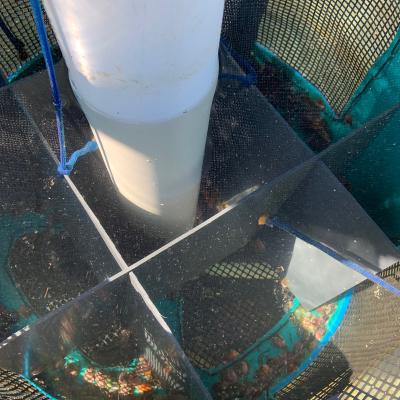When it comes to easing the effects of ocean acidification, it pays to get a little help from your friends.
If your friends are red seaweed, that is.
That’s the takeaway of a recent California Sea Grant-funded study, which looked at whether seaweed could be used to mitigate the impacts of ocean acidification in aquaculture environments. The study, published in the journal Aquaculture, focused on two species: red abalone, a large gastropod mollusk that’s one of California’s flagship farmed seafood species and dulse, a fast-growing seaweed that’s also farmed for human consumption. Researchers found that, when grown together, the dulse helped remove waste-related nutrients and raise the pH of the seawater in the abalone tanks, leading to faster growth rates among the abalone.

Scott Hamilton, a faculty member at Moss Landing Marine Laboratories (MLML) and San Jose State University and lead author of the study, says he and his team chose to study the interaction between these two species because they wanted to find out more about how ocean acidification was affecting aquacultured shellfish, and how aquaculture operations might be able to mitigate future effects of ocean acidification. The study is timely, as ocean acidification is an intensifying problem around the globe: As the ocean absorbs excess carbon dioxide from the atmosphere, its pH decreases and the water becomes more acidic, creating challenges for marine life — particularly those that build calcium carbonate shells and skeletons, including oysters, coral and abalone.
In particular, Hamilton and his team wanted to see if there were ways to mitigate the impact of ocean acidification on early life stages of aquacultured abalone.
“What drew us to this research was a concern about how ocean acidification is affecting shellfish generally in their ability to produce shells and grow, and also trying to think about what consequences there might be for aquaculture operations in the future,” he says. “Particularly, how it might impact earlier life stages of these shellfish at a time when they’re much more vulnerable and you want to give them an advantage to grow.”
The study looked at integrated multi-trophic aquaculture (IMTA), a form of aquaculture inspired by freshwater aquaponics systems, in which tanks of freshwater fish, such as tilapia, are connected to hydroponically grown vegetables such as lettuce. The waste from the fish helps the vegetables grow by acting as fertilizer. In the IMTA setup examined in this study, a tank of dulse grew next to a tank of abalone, with the water from the dulse tank circulating in and out of the abalone tank.
“In this study, we were trying to test not only whether abalone grow better if they were grown in the system with the red seaweed, but how does the recirculation rate — or the water turnover rate — affect how effective seaweed is in removing carbon dioxide from the water?” Hamilton says. “Where we found the most benefit was when you held the water in the system longer, but not so long that the temperature of the water was affected.”
The study found juvenile abalone grew significantly faster — 22 percent in weight and 11 percent in shell area — in six months in tanks with the highest recirculation rates (65 percent of the water retained per hour), compared to tank with a lower recirculation rate (30 percent retained per hour) or no recirculation (non-IMTA, traditional full flow-through system). Recirculation rates higher than 65 percent tended to increase water temperature, while lower recirculation rates didn’t appear to be sufficient enough to allow the algae to scrub CO2 from the system.
These findings could mean an economic boost for aquaculture operations: Typically, abalone take about four years to grow to market size, but growing abalone alongside seaweed in an IMTA system could shave a year off that time frame.
“That could be a very large market savings,” Hamilton says. “And the abalone could be going to market with stronger shells and in better condition than those that were exposed to a low pH system.” Abalone can be fed dulse grown on site, reducing the costs to harvest giant kelp from the wild as abalone feed and adding to the economic benefits of the system.

Hamilton has plans to conduct future California Sea Grant-funded research with colleagues Michael Graham and Maya deVries from MLML/SJSU and Luke Gardner from California Sea Grant, aimed at improving IMTA systems. While the current study focused on two-tank systems, their team is planning to examine the feasibility of single-tank designs, as well as those with continuous lighting, which will ensure the seaweed is consistently photosynthesizing and raising the pH of the water. Until then, he says his research hasn’t shown a downside to growing dulse alongside abalone. Dulse is already used as a food source for abalone, and any excess can be sold to restaurants — when prepared correctly, it can taste like bacon — or to commercial operations.
“By growing another valuable commercial product alongside abalone, farmers can increase and diversify their product portfolio, which may buffer their aquaculture operations from future environmental change or economic downturns” Hamilton says.
Read the full study and learn more about aquaculture in California.
About California Sea Grant
NOAA’s California Sea Grant College Program funds marine research, education and outreach throughout California. Headquartered at Scripps Institution of Oceanography at the University of California San Diego, California Sea Grant is one of 34 Sea Grant programs in the National Oceanic and Atmospheric Administration (NOAA), U.S. Department of Commerce.